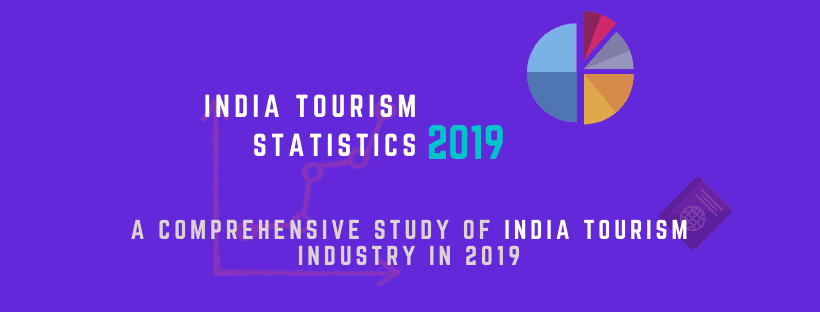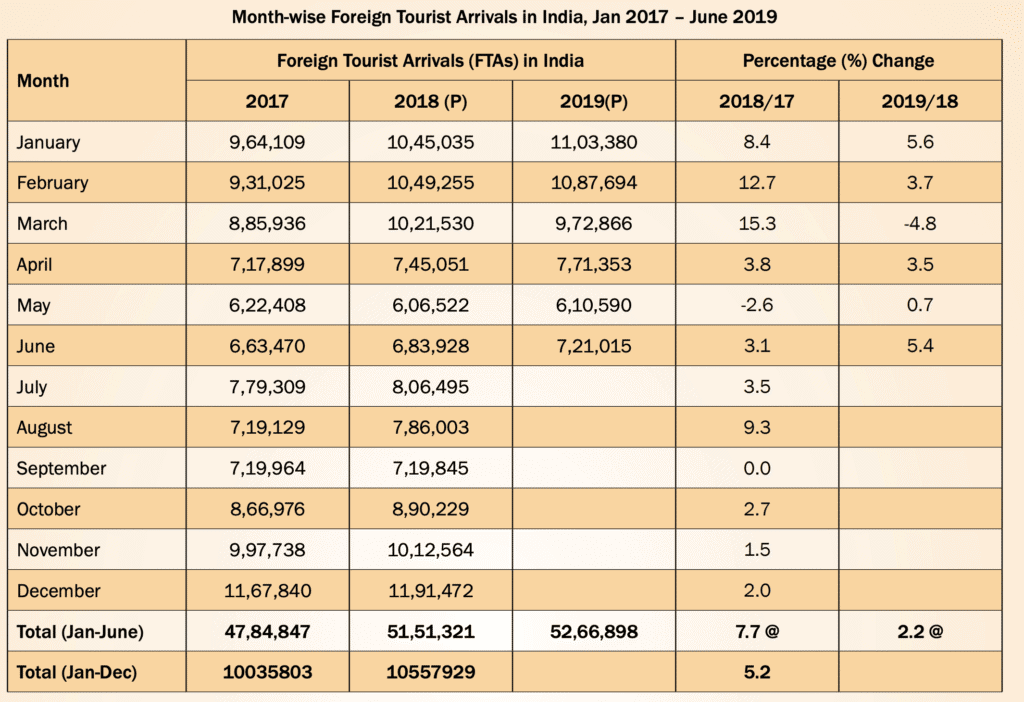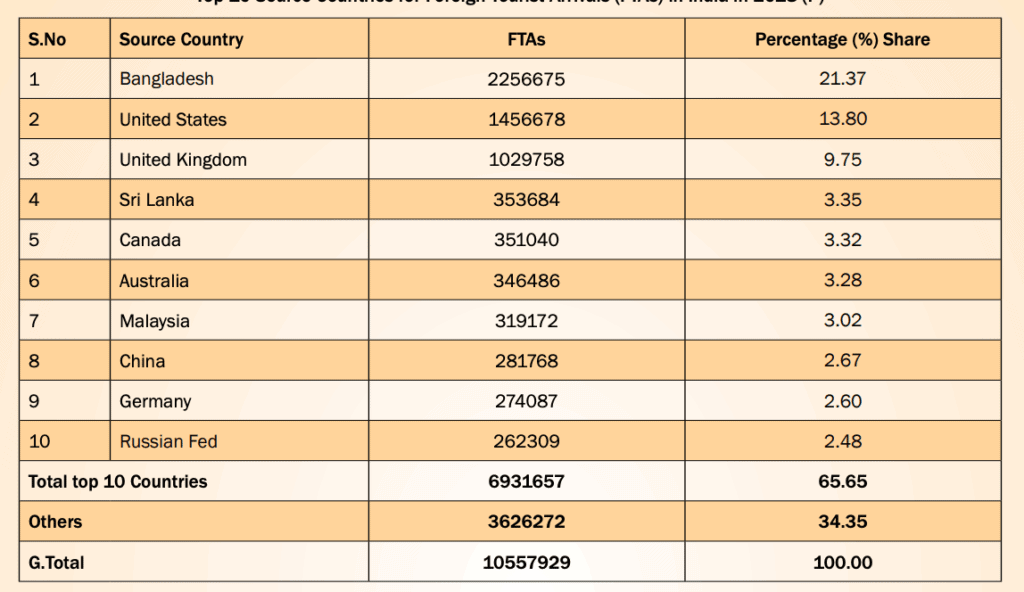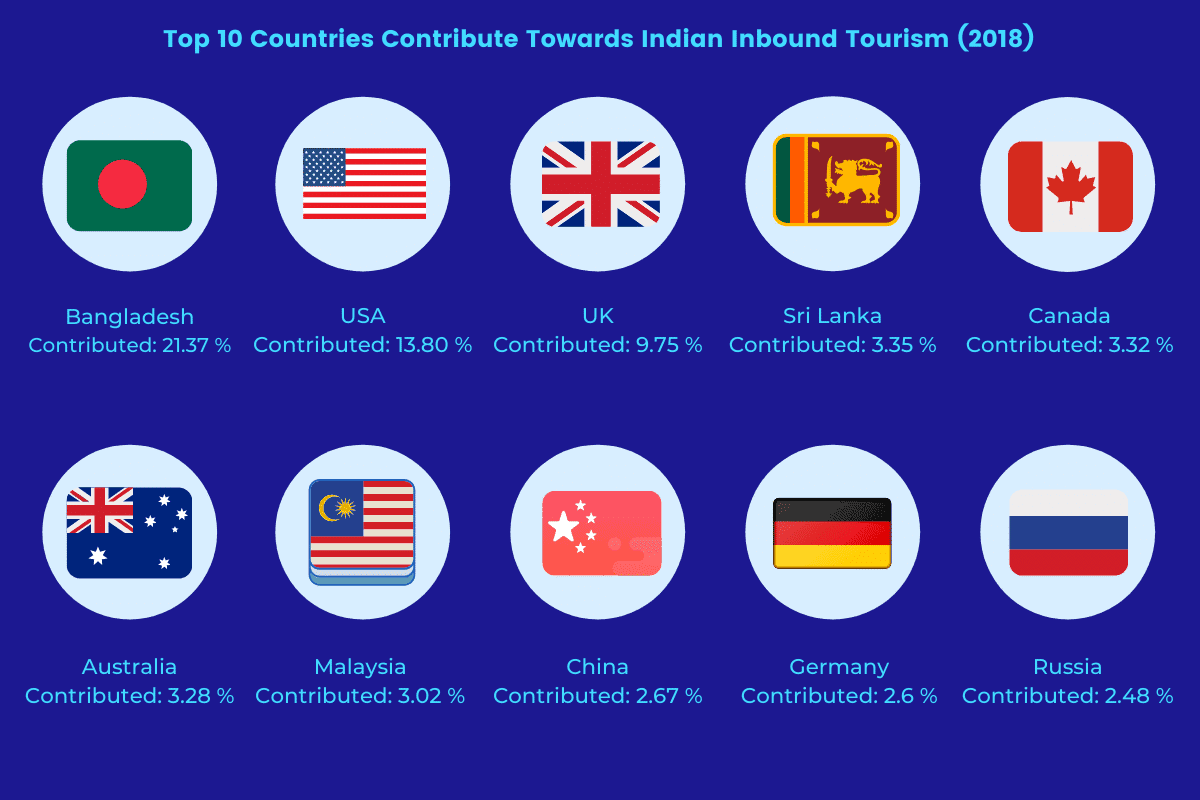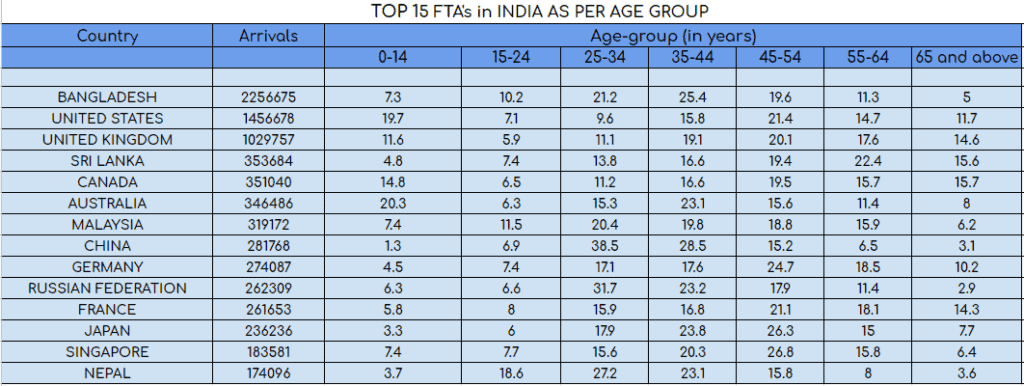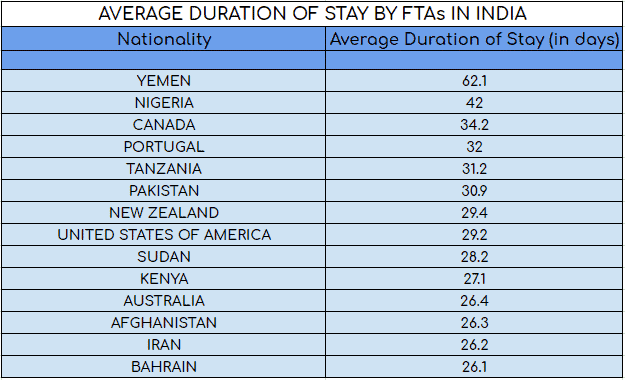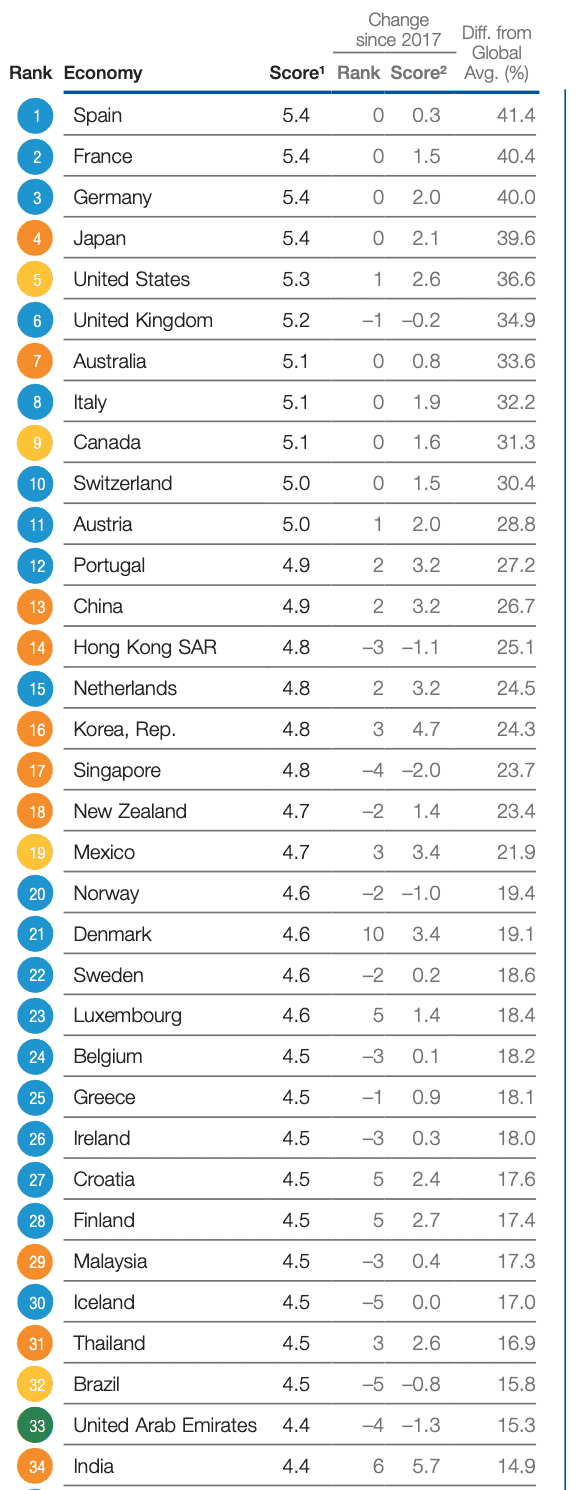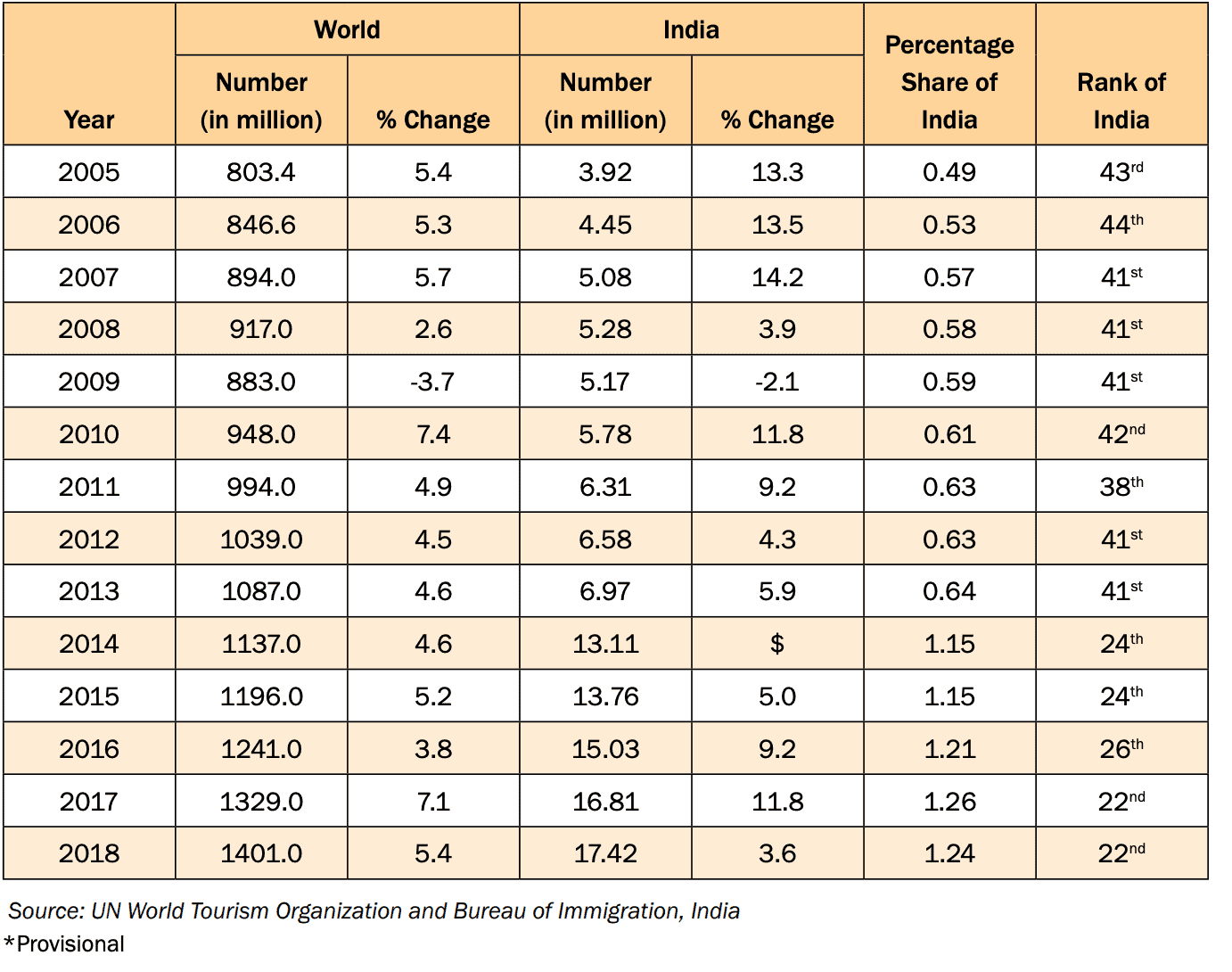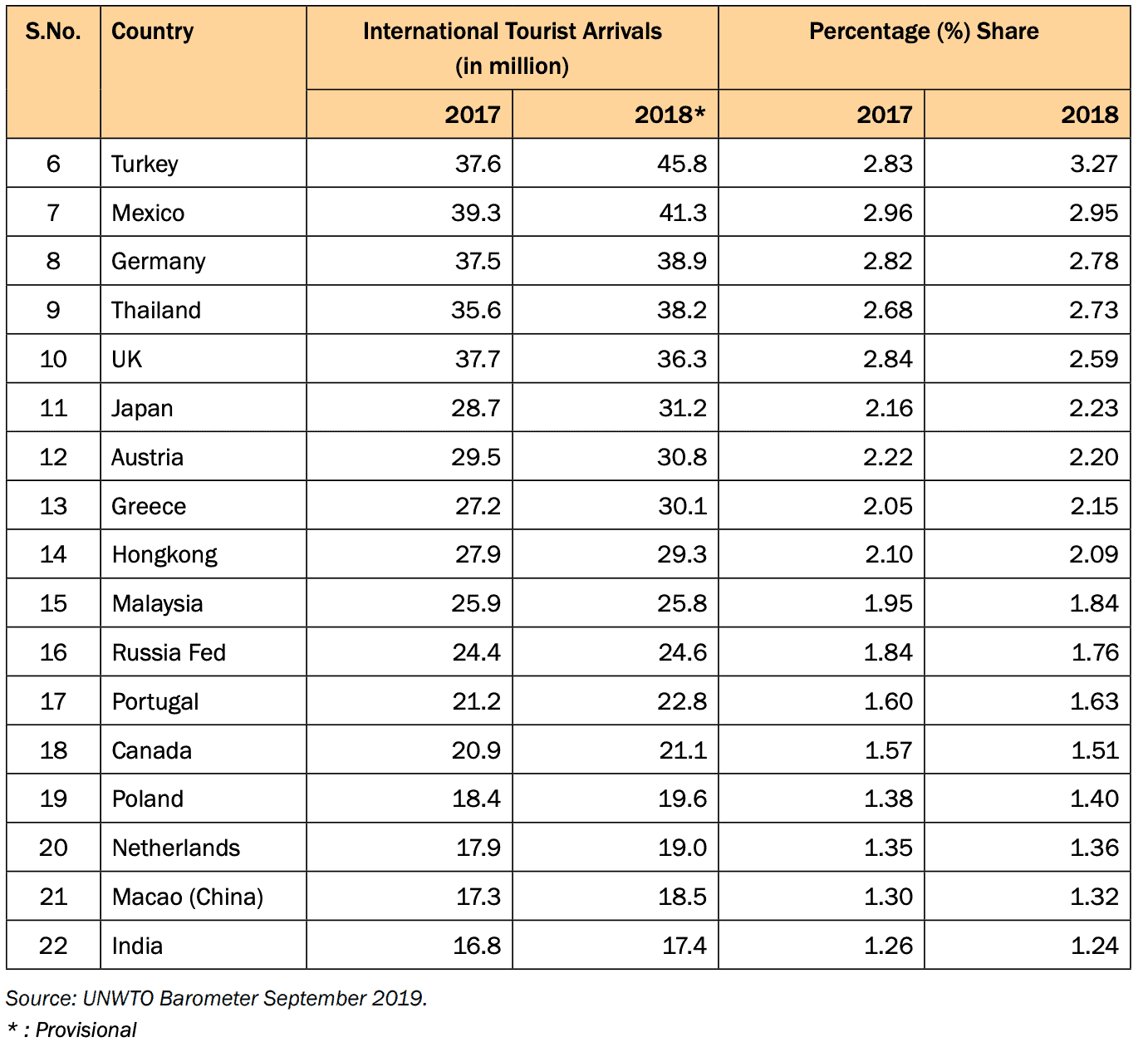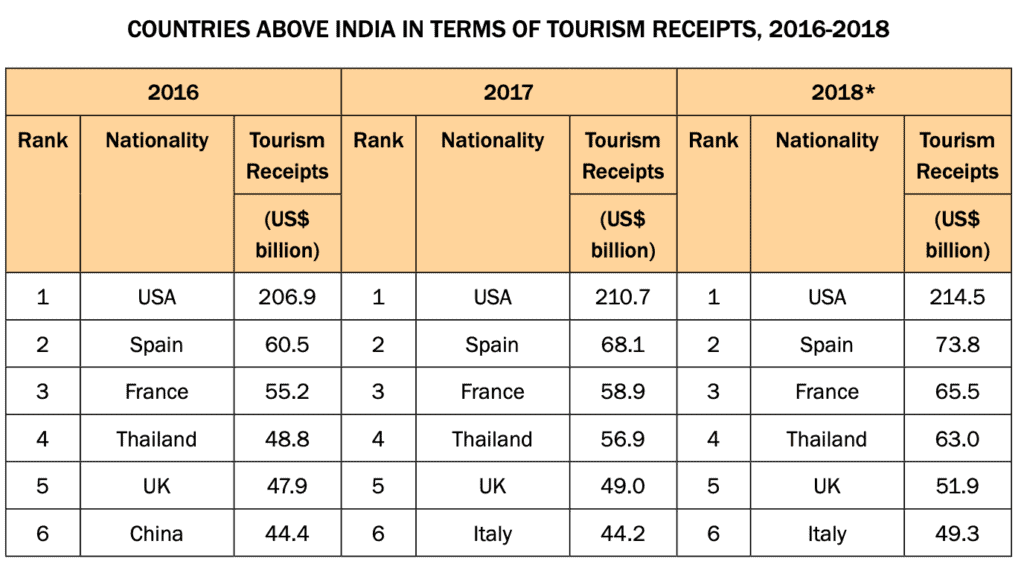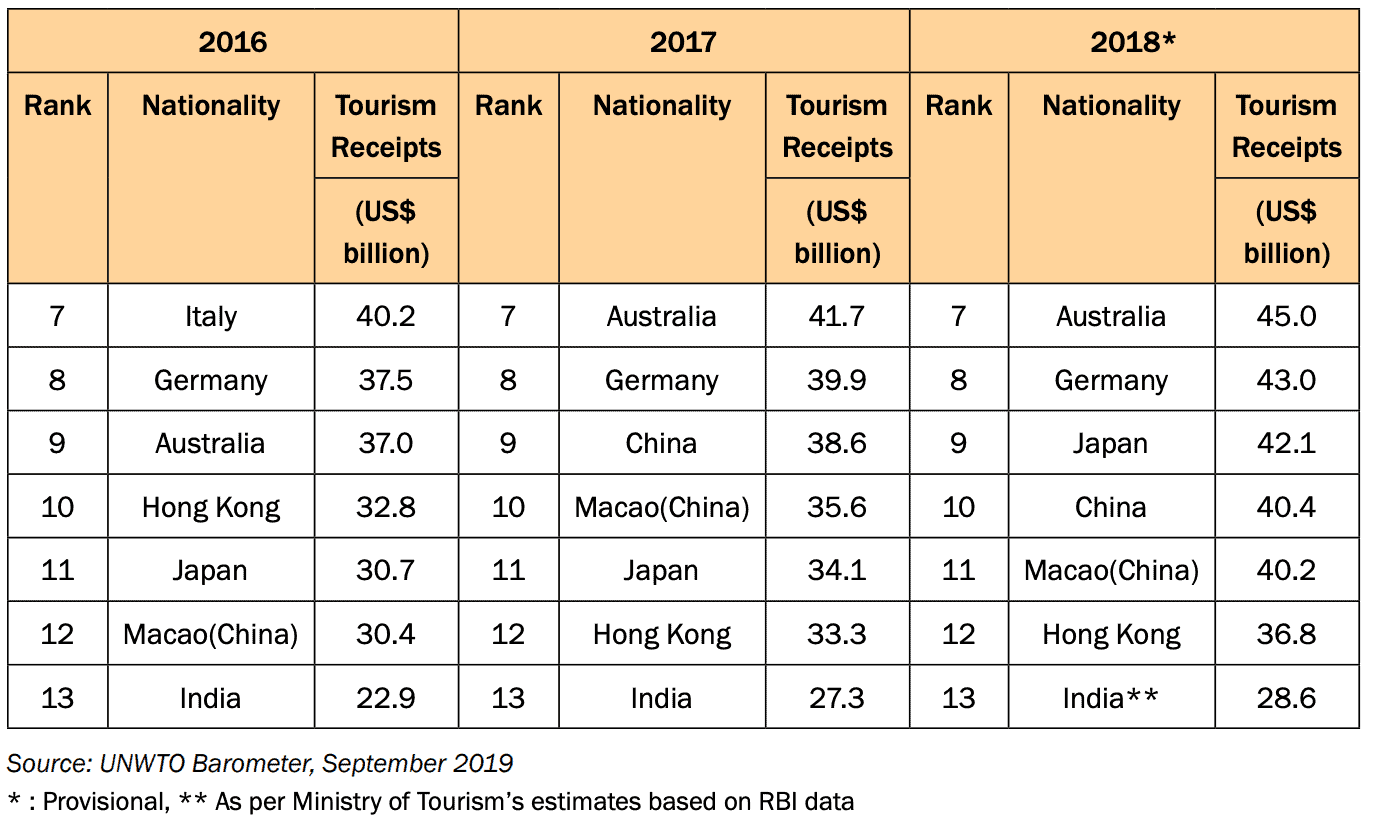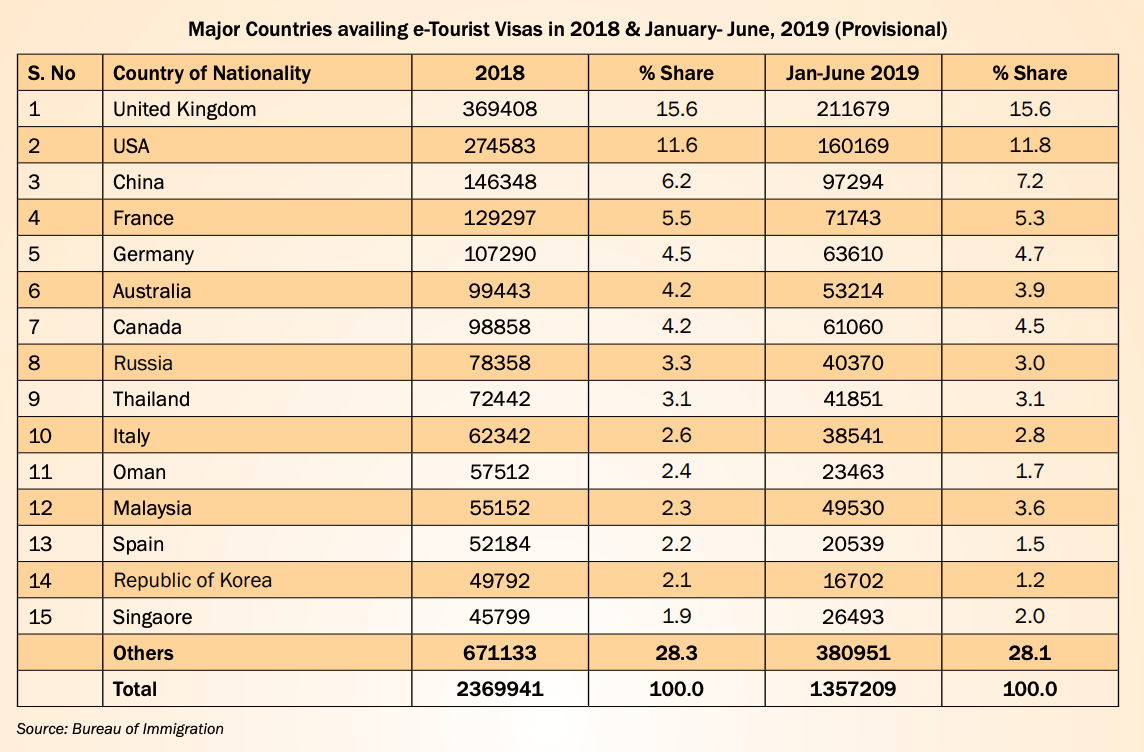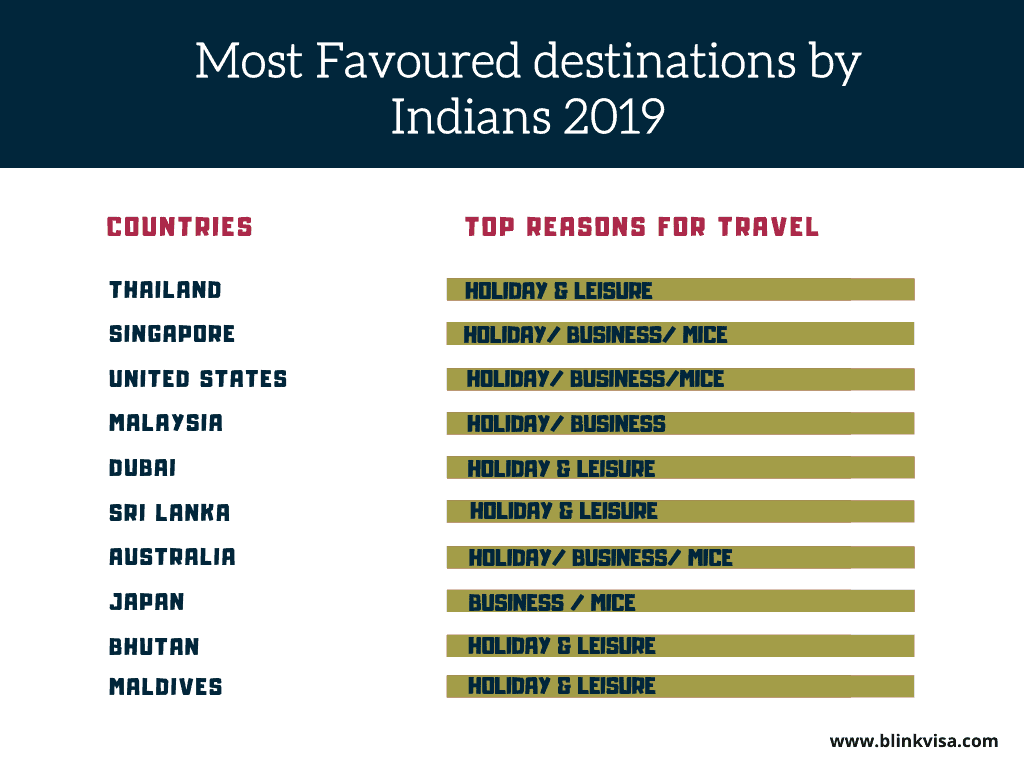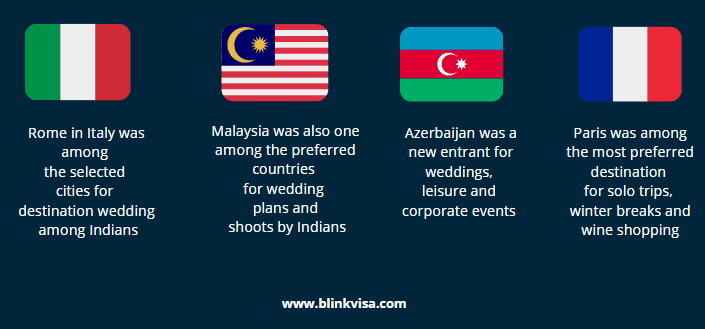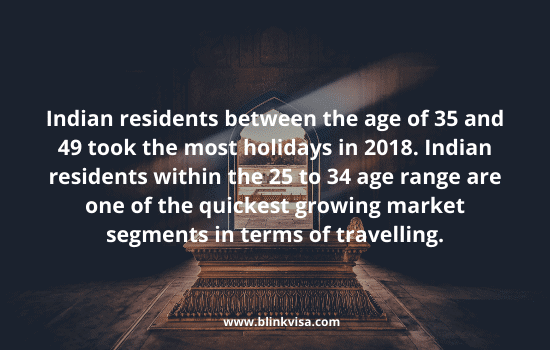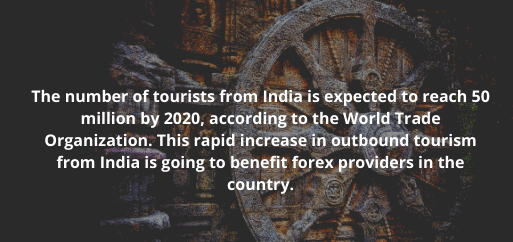This is a summarised, infographic filled version of the official India Tourism Statistics for 2019. All the content of this article can be used freely by anyone. Please feel free to link to or download any content, image or infographic in this article for any purpose.
The statistics in this article is divided into sections:
- India inbound Tourism Statistics – 2019
- Indian tourism compared to the World – 2019
- India E- Tourist Visa Statistics – 2019
- Analysis of the Foreign Tourist Arrivals (FTAs) in 2019
- Outbound Indian Tourism Statistics – 2019
- Most Favoured International Destinations by Indian Tourists – 2019
- Analysis of Outbound Tourism 2019
- Domestic Tourism 2019
- The Road Ahead due to coronavirus
India Inbound Tourism Statistics – 2019
Foreign Tourist Arrivals in India increased by 2.2% (10.7 million) in 2019. But compared to 2017-18,the growth dropped by 3%. The growth rate was 5.5% in 2018. The drop seems to be co-related to elections in March when the number of tourist arrivals dropped by -4.8%.
Overall, India welcomed 28.9 million visitors including NRIs living abroad who visited India for various purposes.
The top 5 source markets for Foreign tourist Arrivals were Bangladesh (21.37%), United States (13.80%) & United Kingdom(9.75%), Sri Lanka(3.35%) & Canada (3.32%). It can be argued that the majority of FTAs from Bangladesh could be to visit friends/relatives, medical treatment or on business rather than purely for tourism.
Total Foreign Exchange Value due to tourism activities is expected to hit $29 billion in 2019. This is a decrease of 3.3% compared to the previous year over the same period, which can be attributed to a decrease in tourist arrivals in the month of March due to national elections.
Seasonality in Foreign Tourist Arrivals in India
Weather condition at different tourist destinations is one of the important determinants of tourist arrivals. In the past, seasonal variations have been observed in FTAs to India. For India, the 1st and 4th quarter of a calendar year constitute the peak quarters.
Gender wise Distribution of Foreign Tourist Arrivals in India – 2019
In 2019, the gender-wise distribution of International Arrivals comprised of 58.6% males and 41.4% females. The male-female break-up of FTAs in 2018 was 59.4% and 40.6%, respectively.
While the proportion of female for most of the countries is in the range of 30% to 50%, for some countries like, Bangladesh, Iraq, Japan, Saudi Arabia and Yemen it was substantially low (less than 30%) in 2018. On the other hand, females out numbered the males in FTAs in India from countries like Mexico (52.2%), Ukraine (54.7), Mauritius (55.2%), Vietnam (57.6%), Myanmar (57.5%), Argentina (57.4%), Thailand (59.8%), Russian Fed. (56.4%) and Kazakhstan (60.2%) during 2018
Age-wise Distribution of Foreign Tourist Arrivals in India – 2019
The highest numbers of FTAs in India were from 35-44 years age group (21.0%) followed by the age groups of 45-54 years (19.8%) and 25-34 years (18.6%). The lowest number of FTAs during the same period occurred in the age-group of 65 & above (8.7%). 2019 data is unavailable yet as of this writing but the variation would be +/- 2-3%.
The proportion of FTAs in India for the age group 25-34 years has been the highest from Eastern Europe followed by Central America, East Asia, Africa, West Asia. In the case of the 35-44 age group, the highest arrivals from East Asia followed by Eastern Europe, South Asia and Central and South America.
Foreign Tourist Arrivals in India According to Purpose
As per the analysis 62.4% of foreign tourist arrivals was for the purpose “Leisure, Holiday & Recreation” followed by Business and Professional (16.3%), Indian Diaspora (13.5%), Medical (6.1%) and Other Purpose (1.7%). The numbers are yet to be released for 2019, but the percentage change is not expected to deviate more than single digits.
80.4% of tourists from Eastern Europe came under the category, “Leisure, Holiday & Recreation” followed by South Asia (74.5%) and Central and South America (73.3%). 50.5% of arrivals from East Asia was under the category Business and Professional followed by Africa (21.9%) and Western Europe (20.6%). 24.2% arrivals from West Asia was for ‘Medical Purpose’ followed by Africa (14.6%)
Average Duration of Stay Of Foreign Tourist Arrivals In India
Tourism is one of the largest foreign exchange-earners. The importance of tourism as an instrument for economic development and employment generation, particularly in remote and backward areas, has been well recognized the world over. The benefits of tourism can be enhanced either by increasing the number of tourists or by increasing the duration of stay of tourists in the country. The nationality-wise data on duration of stay is very important and useful in the targeted promotion of tourism in the source markets.
Though the average duration of stay by foreign tourists in India (22.7 days) is significantly high, there is scope for further increase in view of the availability of a variety of tourism products, culture, cuisine, etc to offer the tourists by India. Among the major source countries, the duration of stay was highest from Yemen (62 days) followed by Nigeria (42 days), Canada (34 days), Portugal (32 days ), Tanzania (31 days) Pakistan (30 days) and USA & New Zealand (29 days each)
The duration of stay was lowest from Oman (11 days) followed by UAE & Myanmar (12 days), Taiwan, Vietnam & Singapore (13 days each), Malaysia, Srilanka & Bangladesh (14 days each), and Mexico (15 days)
Indian tourism compared to the World – 2019
According to UNWTO, International Tourist Arrivals throughout the world grew by 4% to 1.5 billion people. India is expected to grow at 6.8% over the same period. 2019 was another year of strong growth, although slower compared to the exceptional rates of 2017 (+6%) and 2018 (+6%). India was ranked 34th in overall global tourism index in 2019 a jump of 6 places from 40th in 2018.
India’s rank in international tourist arrivals was 50th in 2000 and declined to 54th in 2002. However, since then, it has gradually improved. Since 2014, adhering to the definition of International Tourist Arrivals, India has started the inclusion of figures of arrivals of Non-resident Indians in its figure. This has resulted in an improvement of about 17 places in India’s position. India’s share in international tourist arrivals was, 1.24% in 2018. One among many other reasons for this would be the rising middle class and increasing disposable incomes that have continued to support the growth of outbound and domestic tourism
INTERNATIONAL TOURIST ARRIVALS IN WORLD AND INDIA, 2000-2019
India was placed 22nd in the world in terms of international tourist arrivals into the country. It accounted for 1.24% of the globe’s international tourist arrivals.
INDIA INTERNATIONAL TOURISM RECEIPTS IN $
Tourism Receipts has been increasing steadily since 2002 and has reached 2.0% during 2018. International tourism receipts worldwide, which were hardly US$ 475.3 billion in 2000, have increased by 3.04 times to reach US$ 1448 billion in 2018. In 2019, Indian tourism Receipts were US$ 29.4 billion, about 2% of the international tourism receipts worldwide
India’s rank has also witnessed improvement from 36th in 2000 to 13th in 2018 in earnings in tourism receipts
India was placed 13th in terms of Foreign Exchange Earnings (Tourism Receipts) from Tourism
India E-Tourist Visa statistics 2019
Over 5 million Indian E-Tourist visas were applied in 2019 since it was introduced in 2015. India E-Tourist visa was priced at $100 to free depending on the country of the applicant. This was changed to $25 for all countries in 2019 to boost inbound tourism.
Tourists from UK (15%), United States (11.8%) & China (7.2%) are the biggest applicants on India E-Tourist Visas . France(5.3%) and German citizens (4.7%) are the biggest visa applicants from Schengen States.
Analysis of the Foreign Tourist Arrivals (FTAs) in 2019
DESCENT IN THE TOURIST INFLOW:
- Kerala floods 2018 might be one of the reasons why India may have witnessed a slow visitor arrival. Even though it was in 2018, the impact of the disaster stayed up until the beginning of 2019. Kerala has always received a major share of overseas travellers because of the house boating facilities and impeccable scenic beauty, but the floods were so drastic that it took at least a year for the Government to improve the tourism sectors in the state.
- Pulwama attack 2019 certainly had the tourist sector face a gradual decrease for a few months because of the strict travel advisories issued by the Government and also the curfew that affected the sentiments.
ASCENT IN THE TOURIST INFLOW:
- The Indian tourism ministry initiated the opening of around 137 new peaks in 2019 for mountaineering and trekking as part of the adventure tourism in the states of Jammu and Kashmir, Uttarakhand, Sikkim and Himachal Pradesh. (Ministry of Tourism 2019).
- Reduction of the 1-year Tourist e-visa fee from USD 80$ to USD 40$ made a huge difference in the increase of the overseas visits during the latter half of 2019. Also, the 30 days e-visa fee was also reduced for the period of April to June from 25$ to 10$. (Business Standard 2019)
- Reduction of GST on hotel rooms with tariffs of INR 1,001 -7,500/ per night to 12 per cent, while those above INR 7,501 bracket to 18 per cent would also have paved way for growth in the case of foreign arrivals.
Top government measures to promote inbound tourism
- The government had initiated the development of pilgrimage destinations and also sanctioned 28 new projects in 2019 under the ‘National Mission on Pilgrimage Rejuvenation and Spiritual, Heritage Augmentation Drive‘ as part of PRASHAD Scheme. Pilgrimage tourism is one of the major sources of income when it comes to foreign tourist arrivals in India.
- “Sculpture of Unity”, the popular sculpture of Sardar Vallabhai Patel is that the most perfect and most elevated sculpture in the world with a statue of 182 meters.” The statue constructed and inaugurated in October 2018 generated around revenue of INR 82.51 crore in terms of sightseeing and tourism from January to November 2019.
- Introduced a fresh category of visa, e-Medical visa or M visa to encourage medical tourism in India. The visa facility simplifies the process of getting a visa for tourists who wish to come to India for medical reasons. Thee-FRRO (Foreign Regional Registration Office) sector has also introduced 27 visa-related schemes too.
Outbound India Tourism Statistics 2019
The rich culture, legacy, and melange envelop everything that is beautiful in India and that is the reason as Indians, we generally believe in the importance of outbound travel. Regardless of such diversity, how India is emerging as a great contributor to outbound visitors is always a question. The quick pacing GDP at 7% that straightforwardly deciphers the rising individual pay levels and accessibility of low-cost airfares gave way to a huge change onto the worldwide tourism scene as far as Indian outbound travel industry is considered.
Consistently more than 5.4 million Indians travel to another country for MICE(Meeting, Incentives, Conferences etc), study, shopping, leisure or to visit loved ones.
Most Favoured Countries by Indians for Tourism Purposes in 2019
The land of white elephants, exquisite Thailand proves again to be one among the most favoured destination for Indian travellers and Indians rank number six in overall foreign arrivals to Thailand.
- From January to December 2019 Thailand had about 1.9 million Indian tourists enabling the Thai market phenomenal growth of around 18% compared to 2018. (India Outbound Info 2019).Every single year, many tourists travel to Sri Lanka to enjoy a healthy vacation period. The tourism attraction towards Sri Lanka from India has also enhanced, that is why for those Indians who are willing to go to Sri Lanka, they need to apply for a SriLanka visa for Indians. Most of the tourists have focused intention of visiting the neighborhood destination of the airport district Jaffna that consists of various famous visiting points such as Delt Island, Jaffna Archeological Museum, Sangilean Thoopu, Kandarodei Temple and many others.
- Malaysia also saw an increase in Indian tourists with their advent of eNTRI program and also the waiver of their visa fees. There was a growth of 24.1% in terms of arrivals from India when compared to 2018 and 2017. (Source)
- Japan was a new addition. With an increase in the direct flights to Japan and the upcoming Olympics in 2020, the country definitely hopes to receive a huge growth in Indian tourists. Business visits surpassed tourist visit in both 2018 and 2019.
- The expenditure on the outbound market is growing at a huge rate. Total outbound expenditure inflated from US$23.7bn in 2017 to US$25.4bn in 2018, and an increase of 7% in 2019.
- According to Indian travel analysis, first-time tourists visitors generally prefer to visit Asian countries due to their proximity to India and also fewer travel costs when compared to western destinations. Bhutan, Maldives, Nepal and Srilanka already has India among their top 10 visitor arrivals every year. (Source)
- Also, when it comes to longer stay like visiting relatives or friends for leisure, Indians still favour the United States, Australia, European countries, New Zealand and so on.
Travel motivation and purpose of visit:
The big fat Indian wedding is the second biggest expense made by an average Indian, next only to buying a house. Weddings in India cost as much as a fifth of the entire household saving.
- Singapore has always been in the bucket list of every Indian. With cruise tourism taking a name in recent times, Singapore crossed 200,000 marks in terms of a number of Indian travellers taking a cruise over the past three years. (Source)
- Trek through the foothills of the Himalayas and get acquainted with the people and the natural entirety of the trekking route. Nepal offers several interesting trek routes full of cultural interaction that is unique and beautiful. Explore the Himalayan during the trekking in Nepal and get familiar with the perfectly mixed cultural and natural splendor of Nepal.
- India retained its position as Dubai’s top tourist arrivals with over 1.39 million visitors. Apart from the excellent infrastructure and initiative takes by the Dubai tourism board, the prolonged collaboration of Bollywood star Shah Rukh Khan has also credited to this upscale in number. The Dubai Embassy’s choice to remove kids under 18 from visa expenses throughout the mid-year led to a big increase in Indian families with children visiting by almost 13 % when compared to 2018. (Gulfnews 2019)
Analysis of Outbound Tourism 2019
GROWTH DRIVERS
- The major drive for outbound tourism is the advent of the country’s tourism offices in India which enables better connectivity for planning travel and getting a visa. The eVisa program by many countries and visa on arrival policy has enabled a huge growth in Indians travelling abroad.
- 2019 saw an umpteen addition of direct flights enabling excellent connectivity between several airports around the world with India. The major ones were – Georgia (Tbilisi), Jaffna and Batticaloa in Sri Lanka, Hanoi and Ho Chi Minh in Vietnam and Dushanbe in Tajikistan. Also, exclusive direct flights to New York from Mumbai, Japanese Airlines starting Tokyo to Bengaluru and Lufthansa making way for Bengaluru-Munich flights.
- Air India began flights to Kenya which enabled a good amount of tourist outflow to Africa.
- The middle-class family who wouldn’t mind travelling every year or at least every 2 years followed by those packs of adventurous millennials who are inclined to spend on travelling their heart out rather than save will drove the growth in tourism. In fact, India’s middle-class approximately numbers to more than 350 million people.
- Dubai Shopping Festival had a huge inflow of Indians. An average Indian traveller spends $1,200 per visit as compared with Americans who spend about $700, and British who spend $500. (Forbes India 2017)
CHALLENGES
- The political unrest over Citizenship Amendment Act took a nasty turn for travel towards the end of 2019 and also uncertainty over the path of the Indian economy.
- The exit of Jet Airways from the Indian aviation industry (The New Indian Express 2019) also took a turmoil on the Indian outbound travel. It reduced the number of direct flights to Paris and also summer bookings.
- The challenges of getting an offline visa stamped would also have discouraged Indians to visit countries like US, UK or Schengen ones. Indians mostly prefer online visa or eVisa because of its faster approval and availability.
- The rupee depreciation also became a huge hurdle for the Indian outbound market. United States, Canada, London, France, Italy and Switzerland kept seeing a dip in bookings because of the rupee depreciation.
- Even the preference of cuisine by Indian travellers can be added to the list of challenges. Not all countries have an authentic vegetarian cuisine availability throughout the stay which could discourage Indians to travel outside their home country.
Domestic Tourism 2019
Indians travel domestically 68 times more frequently than foreign trips. Our heritage and culture are spread evenly across the country and that is why people wish to explore more of our architecture and past through many tourist places. Domestic tourism has always been upscale over the past few years. The number grew up to 1.82 billion in 2018-2019.
Most Favoured Destinations within India
- Taj Mahal and Gateway of India are still among the top spots for domestic tourism. Around 40K tourists everyday gather to see the enchanting symbol of love in Agra.
- Tamil Nadu still tops the most visited tourist destination by the domestic tourists over 344 million people. It’s beautiful temple towns and extraordinary architecture have wooed people across India to visit places like Kanyakumari, Kancheepuram, Mahabalipuram and so on.
- Uttar Pradesh, Kerala, Rajasthan and Kashmir follow up with a huge influx of tourists.
Popular Reasons for Domestic Visits
Prime Minister Narendra Modi requested Indians to travel to at least 15 tourist destinations in the country by 2022 with an aim to boost domestic tourism and energise the market.
Government Measures to boost Domestic Tourism
- When taking the country as a whole, India is ranked 10th in price competitiveness, 9th in cultural resources and 24th in natural resources, and 6th in UNESCO’s world heritage sites. These statistics make India among the desirable list for a vacation and that is why people in India must-visit places to help make foreigners discover its beauty. (Economic Times 2019)
- In the recent union budget 2019-20, a new Tax Refund for Tourists (TRT) scheme was introduced to encourage tourists to spend more in India and boost tourism.
- Under the Swadesh Darshan scheme, 15 thematic circuits in the country have been chosen for the development of tourism infrastructure.
- Ministry of Tourism invented a 24×7 toll-free multilingual helpline in 12 languages which will provide information relating to travel in India.
- Propelled Social Media Awareness Campaign named ‘Atithi Devo Bhava’ to build up the significance of good direct and conduct towards tourists.
Growth Drivers For India Tourism Industry 2019
Top 6 Notable Trends in India Travel Industry
1. Data Analytics and Artificial Intelligence
One of the major changes the Indian travel industry is adopting is the usage of artificial intelligence. The technology has brought so many online travel agencies across India to understand their customers. (CIO review India 2019) The data analytics enables 360-degree examination of a consumer’s profile. Also, AI-powered chatbots have also been the latest trendsetter.
According to Google reports (2017), 36% of consumers are willing to pay more for getting their personalized travel preferences using AI.
2. Digital India
Right from booking tickets to getting a visa and travelling, digital trends have taken up in India and have definitely boosted the travel and tourism index. Online visas and platforms to book tickets have helped people to travel at better rates and better options at their own convenience.
According to Booking.com, 80% of customers prefer to self-serve in order to get the information that they need and also 73% of travellers would like to make sustainable travel choices
3. Camping Sites/Solo adventure
Advancement of camping has been encouraged because of the remuneration and its major source for additional economic opportunity. Along with that adventure and cruise tourism has also been widely adopted to increase the inflow of tourists. (Travel Market 2019)
4. Experience-based travel
People are now willing to visit more of unheard places like Tunisia, Jordan, Fiji and so on in order to satisfy their craving for exploring the unexplored cities. Also, health and well-being such as spa experience, dip in hot springs have been ruling every traveller’s itinerary list in recent times(Tripadvisor 2019)
5. Travelling during low season
Travelling during the off-peak period has been a new challenge and excitement among Indians. During a low season, travellers can get air tickets or hotel tariffs at discounted prices and visit their favourite places at their own pace avoiding the crowd. (Forbes 2019)
6. Leisure Travel
A word that is popularly coined using business and leisure, Bleisure means the way people are travelling to get a mix of both professional and personal experience. Travellers can attend their important business meeting along with spending a day or two for a memorable holiday. (Native Planet 2019)
The Road Ahead
India’s travel and tourism industry have enormous potential to grow over every period. Though the beginning of 2020, travel is one among the worst affected industries today because of the novel coronavirus or COVID-19 according to Hindu Business Line, we hope we will kick back and defeat the pandemic in the remaining few months to uplift the economy and boost tourism.
However, the road ahead is still yet to be accomplished and the top strategies for the next few years on the account of Indian tourism would be:
- Infrastructure development, favourable and flexible policies, improvement in railways, airways and roadways will definitely be the focus for 2020.
- Improving internet connectivity/digital bookings in Tier II and Tier II cities is a necessity to boost domestic tourism.
- Safety of foreign tourists in the country is essential to increase the credibility of inbound tourism.
- Reduction in GST in the hospitality sector will induce more inflow and less expenditure.
- Creating a window of opportunity for north-eastern states by building new travel circuits in order to showcase the beauty of states and enable easy and convenient travel.
